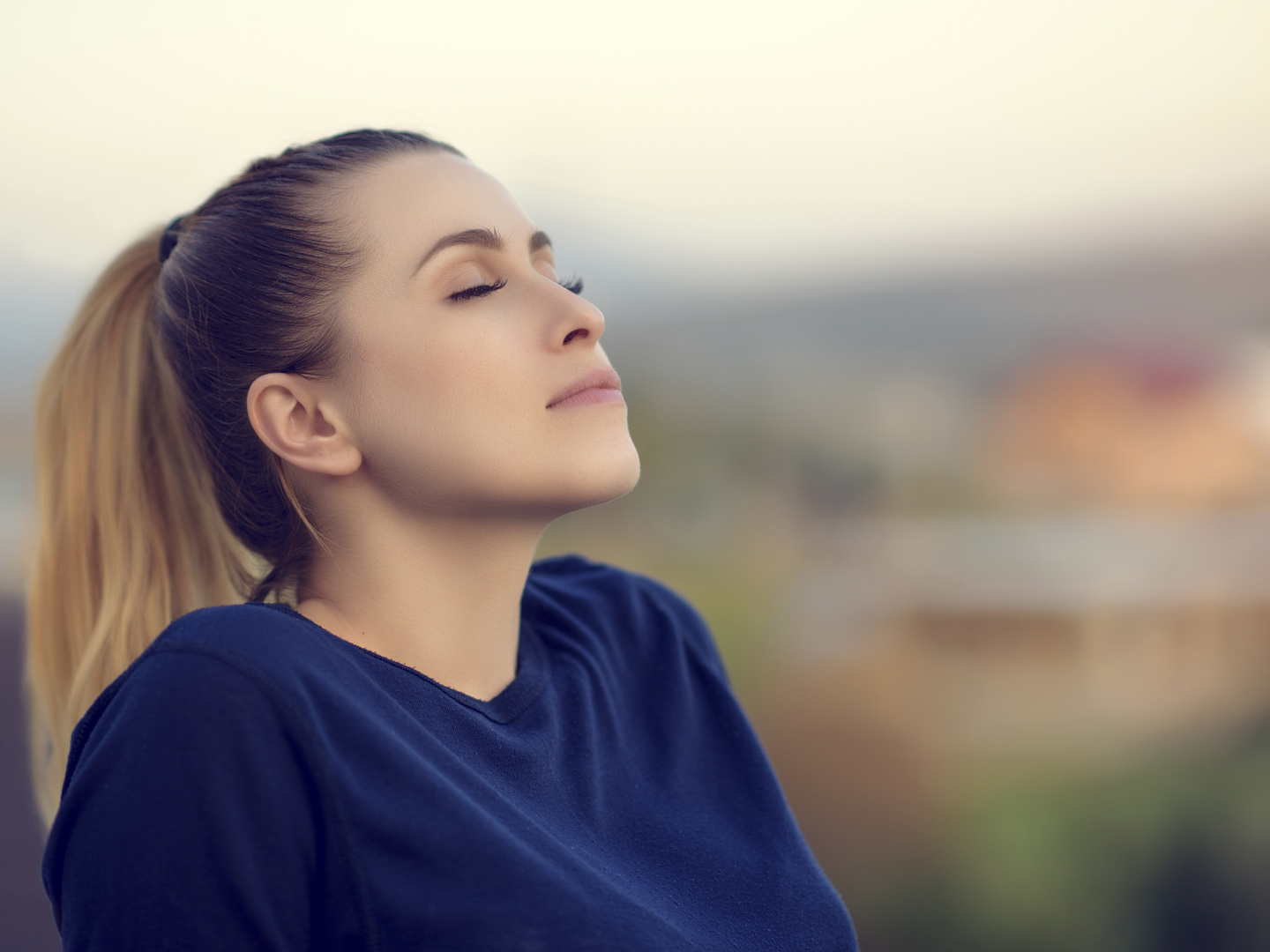Breathing – The first key to healthy living! The foundation of health is a healthy bloodstream, the system that transports oxygen and nutrients to all the cells of your body. If you have a healthy circulation system, you’re going to live a long healthy life. That environment is the bloodstream. What is the control button for that system? Breathing. It’s the way you fully oxygenate the body and thus stimulate the electrical process of each and every cell.

Working with breathing is an effective way to calm the mind. It affects the involuntary control centres in the brain that issue stress and alarm signals to the rest of the body. Breathing exercises have strong, measurable effects on the body. As these exercises relax the mind, they help to oxygenate the blood and, most important, regulate the autonomic nervous system.
Breathing – The first key to healthy living
It’s easy to see the effect of mental states on your breathing patterns. When you’re agitated, your breathing is agitated. Let me suggest a few ways in which you can stimulate your breathing. When you’re angry your breaths are short and uneven. Conversely, when you’re in a peaceful, relaxed state, the breath is long, fine, and barely perceptible.
-
Alternate Nostril Breathing
Sit in a chair with your spine straight or on the floor with a cushion under the hips. Gently exhale all the air from your lungs. Close the right nostril by pressing with thumb of the right hand. Inhale slowly and deeply through the left nostril until the lungs are full. With the lungs full, remove your thumb from the side of your nose and press the left nostril close with your ring finger and exhale through the right nostril. Inhale through the right nostril, slowly and deeply. When the lungs are full again, close the right nostril with your thumb as before and exhale through the left nostril. This completes one round. Begin with then rounds and gradually increase to thirty.
After you’ve acquired the skill of breathing in this way, combine timed breathing with alternate – nostril breathing. Count to ten slowly while inhaling, and then count to ten slowly while to fifteen. When you can inhale and exhale slowly to a count of twenty, change the pattern by halation of fifteen counts and an exhalation of thirty counts. Workup to an inhalation of twenty- five counts and an exhalation of fifty.
Follow your breathing exercise with a mental exercise meant to help you relax deeply and increase your self-awareness. Concentrate on experiencing the present while ignoring thoughts of the past and future, reflecting on your own state in a calm, natural, intentional way. The best results are achieved when this is done every day.
-
Calming the mind
Because thoughts are what make up the mind, emptying the mind of all thoughts gives us an opportunity to achieve a calm, peaceful state of mind. If we can practice achieving this on a daily basis, it becomes a habit. A habit of inner peace is the beginning of a healthy mind.
To begin, sit in a relaxed position with your back straight and your eyes gently focused on the floor in front of you. Sense your breath as it enters your nostrils, and mentally follow it as it fills your lungs and empties from your chest as you exhale. Count each breath (as 1, 2, 3, 4, 5 and so on) without allowing thoughts to interfere. Every time a thought interferes, go back to counting from the number 1. Try counting up to 100 without your mind being disturbed by thoughts.
Do this for ten minutes.
-
Savasana : A relaxing Yoga posture
Take five minutes to relax your body and mind with shavasana (the corpse pose) after you exercise and before you go to bed. The corpse pose looks like a sleeping position to anyone viewing it, but it’s quite different because it’s done with consciousness and awareness. If performed correctly before going to bed, the amount of sleep needed can be reduced and the sleep that you get is much more refreshing.
To begin, lie on your back with palms on the bed or floor facing up. Inhale deeply and exhale through your nose. With each exhalation, visualise all your tension leaving your body. Each exhalation should accomplish this more effectively than the previous one. Sense your body and your hand, feet, abdomen, throat, and eyes getting heavier and heavier as you exhale tension out of your body. Do this for fifty breaths.
-
Deep breathing
Most adults breathe from their chests. Each time you breathe in (inhale) your chest expands. Each time you breathe out (exhale) it contracts. To relax, breathe deeply from your diaphragm, the muscle that separates the chest from the abdomen. You can use deep breathing as your only means of relaxation or as a warmup and cool-down method for other techniques.
-
Progressive muscle relaxation
This technique involves relaxing a series of muscles one at a time. First, raise the tension level in a group of muscles, such as a leg or an arm, by tightening the muscles and then relaxing them. Concentrate on slowly letting the tension go in each muscle. Then move on to the next muscle group.
-
Taking a breather
Here’s an exercise to help you practice deep, relaxed breathing. Rehearse it throughout the day until you can automatically apply it when you feel stressed –
- Sit comfortably with your feet flat on the floor.
- Loosen tight clothing around your abdomen and waist.
- Place your hands on your lap or at your side.
- Close your eyes if it helps you to relax.
- Breathe in slowly through your nose while counting to 4
- Allow your abdomen to expand as you breathe in.
- Pause for a second and then exhale at a normal rate through your mouth.
- Repeat until you feel more relaxed.
There are Pranayama practices to energize you, soothe your body, and quieten your mind. Depending on the technique and your intention, you can use Pranayama to enliven you in the morning, calm you when you are upset, or settle your mind when you are trying to go to sleep.
You can invigorate your body and mind with the breathing technique known as bhastrika or “bellows breath”. This exercise cleanses your lungs while increasing the oxygen flow to your cells and tissues.
Also read KNOW THE SECRET BEHIND EMPTY SPACE IN MEDICINE PACKAGING
comfortably with your spine upright and close your eyes. Exhale all the air from your lungs. Then begin deep in-and-out breathing through your nose silently using the mantras “So” on the inflow and “Hum” on the outflow. For the first twenty breaths take two-second slow forceful inhalation and two-second slow forceful exhalations. It is easiest to keep track of the number of breaths by counting on your fingers.
The next twenty breaths are performed faster with approximately one-second inhalations and one-second exhalations. These are also performed through the nose while thinking “So” on the in-breath and “Hum” on the out-breath.
Finally, perform twenty rapid bhastrika breaths, with approximately half-second inhalations and half-second exhalations. After the twenty rapid breaths, prefer one more slow deep breath and then simply feel the sensations in your body. You will notice that your mind is clear and quiet while your body is energized.
The soothing breath technique known as Ujayi can be used to settle your mind and body when you are feeling frustrated or irritated. When performed correctly it creates a cooling effect at the back of the throat and has a stabilizing influence on the cardiorespiratory system.
Also read Walk your way to a healthy life!
To perform Ujjayi breath, take a slightly deeper than normal inhalation. On the exhalation, slightly constrict your throat muscles so it sounds as if you are snoring. Your out-breath is through your nose with your mouth closed.
You can calm your mind with the breathing technique known as Nadi Shodhana. In English This means, “clearing the channels”. Nadi Shodhana is very beneficial when you are having a lot of anxious thoughts, and when you are trying to quieten your mind. It requires the use of your right hand to alternately close your right and, then, left nostril. Hold your hand so as your thumb, index finger, and remaining fingers are separated. You use your thumb to close your right nostril and your third and fourth finger to close your left.
Take a slow moderately deep breath, and then close off your right nasal passage with your thumb. Exhale slowly through your left nostril, and then inhale slowly through your right nostril, then close off your left nostril with your third and fourth fingers. Exhale through your right nasal passage, inhaling through your left. Continue this pattern for five to ten minutes, alternating the nostril after each inhalation. After just a few cycles you will experience your mind calming and your body relaxing.
The breathing meditation technique is no doubt beneficial but there are a few cautions to keep. Set aside some time when you’re free from work or family responsibilities. Find a quiet place where you will not be disturbed. Sit quietly on the floor or in a straight-backed chair. Close your eyes. Begin by simple exhaling and inhaling as you normally do, but gradually focus your awareness on the process of your breathing. But don’t try to control or influence it in any way. Just be aware of the coming and going of your breath. If you notice your breath speeding up or slowing down-even stopping for a moment-simply observe this.

Don’t try to resist. Just allow your attention to gradually and naturally return to your breathing. Continue the Breathing Meditation technique for fifteen minutes. Allow yourself another few minutes for withdrawal from the techniques, still sitting with your eyes closed.
Then open your eyes and resume your normal activities.
There is only a line that can be said about breathing techniques, there is no food or vitamin pill in the world that can do for you what excellent breathing patterns can do.




